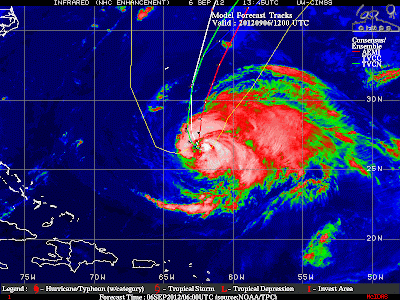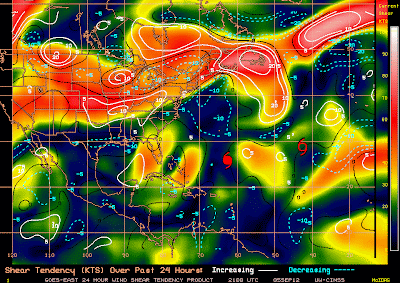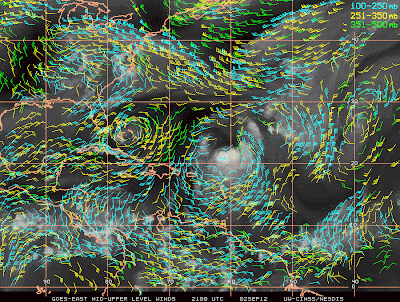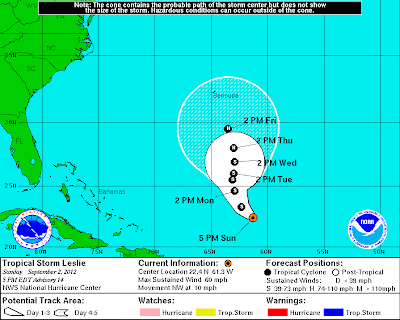Leslie does not look very healthy with the circulation center open across most of the western semicircle. The shear is increasing and moving closer to the storm from the west.
The track hasn't changed much, and neither has the intensity forecast from NHC. I will go out on a limb here though. The shear tendency and lack of organized core will likely mark the demise of Leslie's chances to re-intensify.
An earlier visible satellite image from Leslie shows arc clouds in wavelets rounding the northwest quadrant of the storm. Likely caused by gravity waves emulating from looks like a mid level vorticity north of the low level center. These could help the scouring out of the environment across the western edge. To show this and because I'm off after a long set of long shifts, I thought I'd have a little fun and make a video of the visible images. Testing out the Stupeflix application.
As for the Gulf of Mexico and the not very interesting mess there. Down to 20% chance for development but the circulation is looking weak much less that the convection is totally displaced.
Many things weather related mainly focusing on tropical weather in the Atlantic Basin
Friday, September 7, 2012
Thursday, September 6, 2012
Track for Leslie behaves well. Updated
The forecast track this evening is more to the east again:
The latest track forecast continues the eastward shift due to the trough over New England picking up the upper level low east of the FL/GA coast. This low will slowly move northeast while blocking the path of Leslie, and moving the path to the east. A loop of the water vapor imagery clearly shows the trough moving the upper low. http://www.goes.noaa.gov/HURRLOOPS/huwvloop.html
Will keep this post short but it is good news for Bermuda.
Here is what the storm looks like...
You'll notice the bulk of the vigorous convection on the northern and eastern quadrants of the storm. The last graphic will show the forecast track of the storm.
The latest track forecast continues the eastward shift due to the trough over New England picking up the upper level low east of the FL/GA coast. This low will slowly move northeast while blocking the path of Leslie, and moving the path to the east. A loop of the water vapor imagery clearly shows the trough moving the upper low. http://www.goes.noaa.gov/HURRLOOPS/huwvloop.html
Will keep this post short but it is good news for Bermuda.
Here is what the storm looks like...
You'll notice the bulk of the vigorous convection on the northern and eastern quadrants of the storm. The last graphic will show the forecast track of the storm.
Wednesday, September 5, 2012
Leslie future track is further east
The National Hurricane Center NHC has upgraded Leslie to hurricane status this afternoon. From the satellite presentation and Oceansat-2 winds I think this is a prudent assesment of the strength in the core of Leslie.
On the wider view of the Oceansat data we see a very good circulation that is tilted eastward with the strongest winds over the northeast quadrant. Unfortunately NOAA and the Air Force Hurricane Hunter Aircraft are not flying into the storm. NASA is sending a Global Hawk over the storm tomorrow which may reveal the upper flow patterns and more about the tilt of Leslie, providing additional information for the models. This could help to pin down the track even more. A closer view of the Oceansat data (below) shows 65 knots from satellite derived winds near the center of circulation just northeast of the center.
The visible satellite view shows a slightly better organization to the storm today.
The track has shifted to the east as mentioned above, although possibly due more to the upper low northeast of Bermuda than the trough moving across the New England Coast.
There is some developing wind shear to the west of Bermuda with a COL region (region of little winds and wind shear) to the north of Bermuda.
While the change in track isn't great news for Bermuda, it is better news. If the track continues the shift to the right I would expect the impacts will be less due to the stronger winds in eastern semicircle. Everyone I know, not many, in Bermuda are prepared and waiting.
Be Safe!
BC
On the wider view of the Oceansat data we see a very good circulation that is tilted eastward with the strongest winds over the northeast quadrant. Unfortunately NOAA and the Air Force Hurricane Hunter Aircraft are not flying into the storm. NASA is sending a Global Hawk over the storm tomorrow which may reveal the upper flow patterns and more about the tilt of Leslie, providing additional information for the models. This could help to pin down the track even more. A closer view of the Oceansat data (below) shows 65 knots from satellite derived winds near the center of circulation just northeast of the center.
The visible satellite view shows a slightly better organization to the storm today.
The track has shifted to the east as mentioned above, although possibly due more to the upper low northeast of Bermuda than the trough moving across the New England Coast.
There is some developing wind shear to the west of Bermuda with a COL region (region of little winds and wind shear) to the north of Bermuda.
While the change in track isn't great news for Bermuda, it is better news. If the track continues the shift to the right I would expect the impacts will be less due to the stronger winds in eastern semicircle. Everyone I know, not many, in Bermuda are prepared and waiting.
Be Safe!
BC
Monday, September 3, 2012
Leslie looking better today.
The satellite presentation from Leslie looks much different than 24 hours ago. From visible satellite loops earlier in the day, the center circulation started out exposed from the vigorous convection to the south and east. Latest satellite interrogation shows the convection is wrapping around the circulation again late this afternoon. This likely signifies a storm at least better better organized. Also think this may induce a period of intensification for several reasons. Here is a look at Leslie
The ripples near the brightest white are gravity waves propagating outward from the deep convective burst. This image is a little old, couple of hours, but shows the convection engulfing the center of circulation. The image below shows how intense the convection really is with -80 Celsius and colder cloud tops.
The forecast track has shifted ever so slightly to the west likely due to the forecast models as we haven't really had any trends to follow for the last day or two. The forecast will likely change over the next few cycles as the storm gets its act together so this is not hard and fast yet. My thoughts are if the storm moves west of Bermuda this places the Island in the higher risk area of Leslie. The right front quadrant has statistically the highest winds, more likely to have tornadoes, and greatest storm tides/surge. Recent Oceansat 2 satellite pass shows the winds around Leslie quite well.
The winds are highest on the east side of the storm which reinforces the idea of the right front quadrant as the most potent area of the storm. Another reason that Leslie may intensify is that the shearing around the storm has relaxed, as has the shear tendency.
The NHC wind probabilities indicate that the chance of Leslie reaching hurricane strength is about 50%. Again I think that this may change sometime through the next few forecast cycles due to the more favorable environment around the storm, and better storm-centric organization.
The next few graphics show the numerical probabilities, and updated Tropical Storm/Hurricane force winds graphics.
For my friends in Bermuda, the best advice I can offer is to be prepared. Speak with people that have been there a long time as they will have local experience that will prove invaluable. The folks along New England should be keep a watchful eye on Leslie just in case. I do think the models, especially the GFS...Global Forecast System...have a good handle on the track after 5 days taking the storm, northward, then northeastward with the greatest impact to the Canadian Maritimes before heading out to the North Atlantic.
I will keep an eye on this one. Leslie is at least proving interesting from a forecasters point of view. Last note...surfers along the Eastern Seaboard, and the boarder islands between the Caribbean and Atlantic are going to have great surf.
Be safe,
BC
The ripples near the brightest white are gravity waves propagating outward from the deep convective burst. This image is a little old, couple of hours, but shows the convection engulfing the center of circulation. The image below shows how intense the convection really is with -80 Celsius and colder cloud tops.
The NHC wind probabilities indicate that the chance of Leslie reaching hurricane strength is about 50%. Again I think that this may change sometime through the next few forecast cycles due to the more favorable environment around the storm, and better storm-centric organization.
The next few graphics show the numerical probabilities, and updated Tropical Storm/Hurricane force winds graphics.
I will keep an eye on this one. Leslie is at least proving interesting from a forecasters point of view. Last note...surfers along the Eastern Seaboard, and the boarder islands between the Caribbean and Atlantic are going to have great surf.
Be safe,
BC
Sunday, September 2, 2012
Leslie hangs in, Friday's comin!
'Leslie keeps chugging away even though the environment surrounding the system is quite hostile, and the storm itself is rather disorganized. A look at satellite shows some convection near the center of the circulation, but not surrounding it. All images with a few exceptions are from CIMSS: Cooperative Institute for Meteorological Satellite Studies
Space Science and Engineering Center / University of Wisconsin-Madison
From the image above we see the "one sided" appearance with most of the convection held to the southern hemisphere of Leslie. The reason for this is the shear in the environment around the storm. The next several images will help describe this better than words.
First the shearing environment,
Notice the shear values on the northeast and west quadrants between 40 and 50 knots. The shear tendency is increasing as well in these areas.
To verify this we have several polar orbiting satellites with good passe near the storm, first the Oceansat-2 (OSCAT) observations, followed by the Advanced Scatterometer, (ASCAT)
Notice the higher winds on the east semicircle indicating the shear to the east. Looking further out from Leslie we find the mechanisms responsible for the slow and indecisive motion of the storm during the past 24 hours or so.
Total winds show the upper level low parked over the Bahamas which has begun to retrograde to the west. A trough across the southeast is pushing toward the northern Gulf of Mexico, and a mesoscale ridge is stalled over the northeastern Gulf. A better look at the upper levels only reveals the low very well.
So where is Leslie going? Not very far very fast. Plus the environment may become less hostile for redevelopment late in the forecast. From CIMSS:
From NHC the official forecast which is easier to look at but I like the display from CIMSS better:
The forecast beyond this time frame is uncertain but I am certain that some sources in the media will be touting the future of the storm and the model output. So to soften this I will show you the extended models in the order of the (GFS) Global Forecast System, (ECMWF) European Medium Range Forecast, and the (CMC) Environment Canada models. Environment Canada has proven to be the intensification model of choice.
All show some significant intensification after 5 days while picking up forward speed and heading for the Canadian Maritimes. This we will have to wait for. The model errors are significantly higher in the extended time periods of the forecast.
Be well,
BC
Space Science and Engineering Center / University of Wisconsin-Madison
From the image above we see the "one sided" appearance with most of the convection held to the southern hemisphere of Leslie. The reason for this is the shear in the environment around the storm. The next several images will help describe this better than words.
First the shearing environment,
Notice the shear values on the northeast and west quadrants between 40 and 50 knots. The shear tendency is increasing as well in these areas.
To verify this we have several polar orbiting satellites with good passe near the storm, first the Oceansat-2 (OSCAT) observations, followed by the Advanced Scatterometer, (ASCAT)
Notice the higher winds on the east semicircle indicating the shear to the east. Looking further out from Leslie we find the mechanisms responsible for the slow and indecisive motion of the storm during the past 24 hours or so.
Total winds show the upper level low parked over the Bahamas which has begun to retrograde to the west. A trough across the southeast is pushing toward the northern Gulf of Mexico, and a mesoscale ridge is stalled over the northeastern Gulf. A better look at the upper levels only reveals the low very well.
So where is Leslie going? Not very far very fast. Plus the environment may become less hostile for redevelopment late in the forecast. From CIMSS:
From NHC the official forecast which is easier to look at but I like the display from CIMSS better:
The forecast beyond this time frame is uncertain but I am certain that some sources in the media will be touting the future of the storm and the model output. So to soften this I will show you the extended models in the order of the (GFS) Global Forecast System, (ECMWF) European Medium Range Forecast, and the (CMC) Environment Canada models. Environment Canada has proven to be the intensification model of choice.
All show some significant intensification after 5 days while picking up forward speed and heading for the Canadian Maritimes. This we will have to wait for. The model errors are significantly higher in the extended time periods of the forecast.
Be well,
BC
Subscribe to:
Comments (Atom)


































